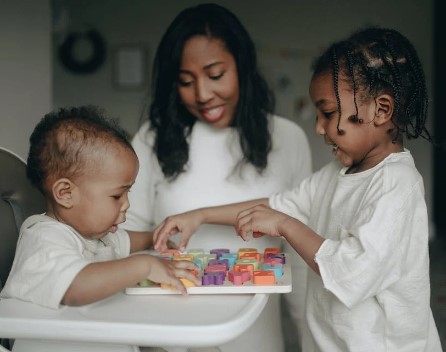‘Follow the child’ in Montessori lingo is described in context with ‘prepare the environment’ and ‘observe without judgement or interference’. When you understand the latter two statements then following the child makes coherent sense.
Montessori believed that a child is born with and develops [insert appropriate pronoun] own interests, thoughts, ideas and purpose naturally. Adults can only learn of these through observing the child.
Each individual is born a natural learner; we learn how to walk, talk and manoeuvre our bodies, for example, with increasing astuteness as we develop into adults. Children learn by doing, using their senses to better understand the world. Children always communicate their needs and what it is they seek to develop through their actions. So by following the child’s movements and utterances we begin to understand the ways in which we can support the child to develop. By following the child, adults can clearly see where a child needs support in developing fine and gross motor skills to pour a glass of drink for themselves by themselves, for example.
Take for example a child who is learning how to walk. Even if we wanted to, we cannot literally teach the child to walk by standing [insert appropriate pronoun] up and placing one foot in front of the other for them. We can, however, follow the child’s attempts to walk and notice that [insert appropriate pronoun] may be ready to stand and attempt walking on [insert appropriate pronoun] own. What most adults do when observing this is to support the child by holding their hands and ensuring the floor is cleared of any obstacles the child may trip on whilst practising this new skill. This would be preparing the environment after following the child!
Preparing the environment simply looks like viewing the environment from a child’s perspective. If you have ever visited a Montessori setting, you will find that it looks like the home but everything in it is of a child’s size. This is because children are more than capable of learning everything we can do as adults when shown how to do so using tools that are appropriate for their size. Practical life activities which most adults find mundane such as wiping the table after a meal, doing the washing up or sweeping up crumbs from the floor are all very exciting tasks children love to get involved with at a young age. Having in the environment smaller tables, washing bowls and dustpan and brushes gives the child an opportunity to engage in developing [insert appropriate pronoun] motor skills and coordination as well as boosting their agency and involvement in everyday life at home. Once the environment is prepared all that’s left to support a child’s development is to observe without judgement or interference and model the desired behaviour.
Observing without interference and without judgement is a skill that takes time to develop in adults as we are quick to ‘come to the child’s rescue’ and offer unnecessary help whenever we think the child is incapable of doing a task effectively. Our misjudgements often squander so many learning opportunities for the child when we attempt to support in this way. Learning how to observe without interfering (unless there is imminent danger to the child) allows us to develop a ‘curriculum’ for the child. Observing without interference or judgement allows us to see where the child truly needs our support and gives us the opportunity to prepare the environment where the child can develop the skills [insert appropriate pronoun] needed to master their interests independently.
Following the child is a most liberating act for both child and adult. It ensures that the future of humanity is protected, celebrated and supported in equitable and unfettering ways; it avoids mislabelling and makes facilitating the education of the child a most enjoyable and eye-opening experience.
For more information about how best you can follow your child effectively, please do book a consultation.

